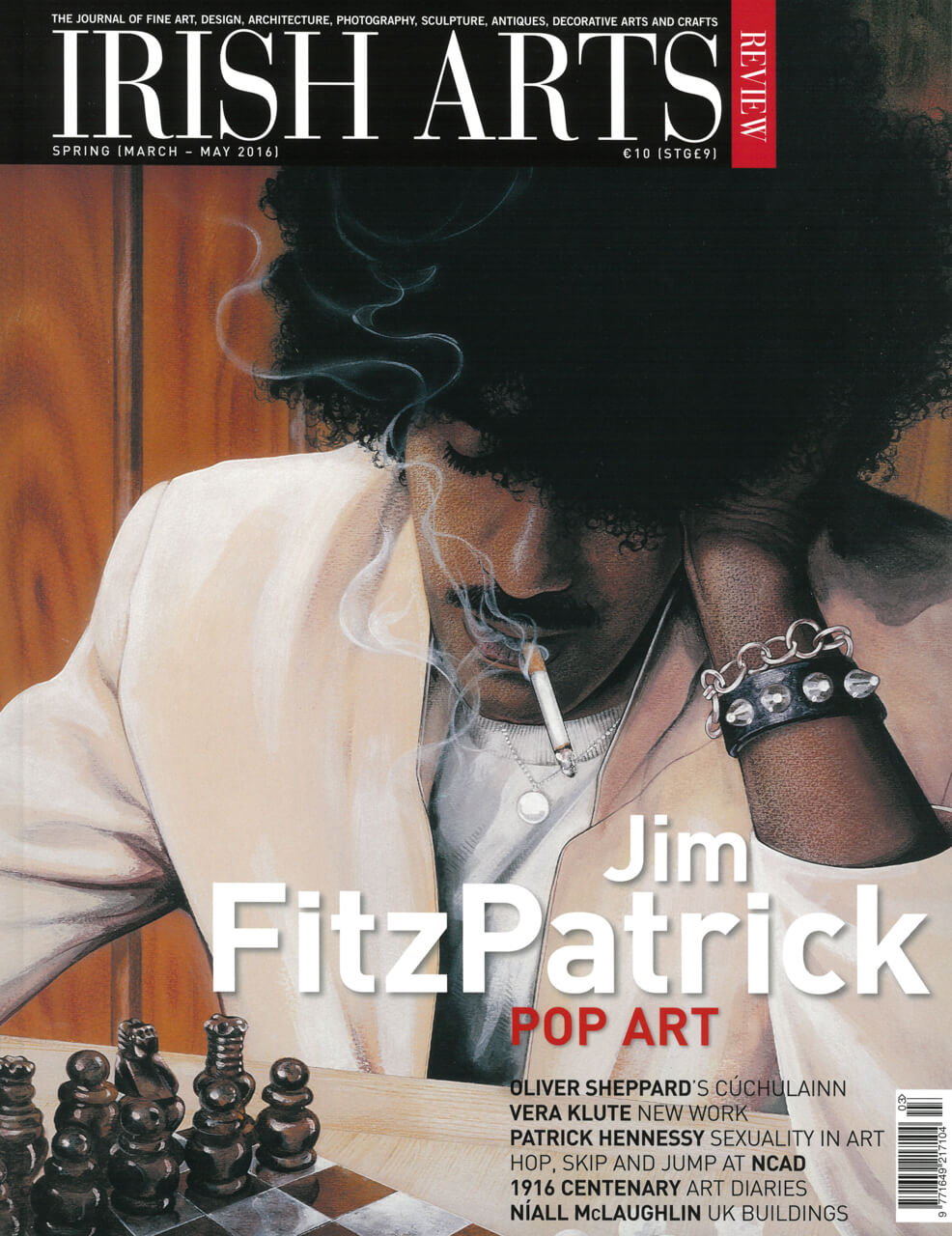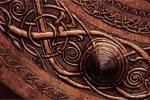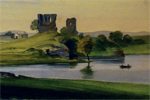
Paula Murphy examines the political character of Oliver Sheppard’s work as exemplified by C√∫chulainn and his all’antica portrayal of Padraig Pearse.
A statue’s there to mark the place, / By Oliver Sheppard done.(1)
W B Yeats
These words, in Yeats‚’ last play written in 1939, refer to Oliver Sheppard’s statue of the Death of C√∫chulainn (Fig 2), which had been unveiled in Dublin’s General Post Office (GPO) in 1935. This sculpture has ensured that Sheppard is forever associated with the Easter Rising, because it was chosen to serve as the official memorial to the events of 1916. However, it was not created for that purpose, nor was Sheppard an active participant in what took place in Dublin at that time. According to his daughter in conversation with this writer, April 1983, Sheppard was not a political person. Nonetheless, he affirmed his desire for Ireland, when he was reported as having said that ‘this country should be a free country‚’ (Irish Press, 24 March 1937). Nowhere is his political position more evident than in his work – both his subject pieces and and his commemorative sculptures – much of which is indicative of nationalist leanings. The selection of his C√∫chulainn statue to commemorate 1916 serves as confirmation, although the work was never intended for such a lofty purpose. Modelled in plaster in 1911, Sheppard exhibited his Celtic subject piece at the Royal Hibernian Academy (RHA) in 1914, in anticipation of attracting a patron to commission the casting of the work in bronze. The work received little attention at the time and was returned to the sculptor’s studio, where it remained, in spite of subsequent interest from a number of sources, until Eamon de Valera, then President of the Executive Council (head of government) chose it for its present purpose in the early 1930s. The bronze casting was carried out by the Compagnie des Bronzes in Brussels and the work was installed in the GPO towards the close of 1934. It was curious that de Valera chose 1935 – nineteen years since the Rising – for such a significant event, rather than the following year. Nonetheless, the unveiling of the sculpture on Easter Sunday (21 April) in 1935, accompanied by drum beats and bugle blasts, was remarkable for its pomp and ceremony. Although Yeats thought it ‘a bad statue‚'(2), it seemed inevitable that Sheppard’s C√∫chulainn would become one of the most familiar and popular sculptures in Dublin.
The renewal of popular interest in the Celtic warrior had commenced early in the 20th century with the publication of Lady Gregory’s translation of the legend in 1902, which included an introduction by Yeats. Sheppard had already tackled the narrative in his work The Training of C√∫chulainn, exhibited at the RHA in 1897, which depicts the youthful figure being educated in warfare. However, the sculptor’s subsequent work sees him transformed into a hero. The legendary heroic sacrifice seemed a fitting commemoration for those who gave their lives in 1916, men who, according to Yeats, ‘had C√∫chulainn so much in their minds.‚'(3) In his poem The Statues (1938), Yeats writes of Padraig Pearse, in the GPO, summoning C√∫chulainn to his side. John Burke, solicitor, art collector and friend of de Valera, was instrumental in getting the political leader to visit Sheppard’s studio to see the work. That C√∫chulainn had a confused legacy seems not to have been a consideration at the time, although this has become more evident since, particularly in the North of Ireland where, in propagandist mural paintings, the legendary figure is used by Nationalists and Loyalists alike.
Born in his parents‚’ native Cookstown, Co Tyrone, Oliver Sheppard (1865-1941)(4) was raised in Dublin, where his father had established a marble workshop in the early 1860s. He registered as a student at the Dublin Metropolitan School of Art (DMSA) in 1884, followed in 1889 by his brother Reuben. These two sons may be seen, at the time, to have surpassed their artisan father, by establishing themselves as fine art sculptors.
The 1880s witnessed a strong intake of would-be sculptors at the DMSA. In addition to Sheppard, there were John Hughes (1865-1941), Mervyn Lawrence (1868-1961) and Michael Shortall (1868-1951), who were to become the new generation of sculptors, taking over the mantle from John Henry Foley (1818-74) and John Hogan (1800-58), Thomas Farrell (1827-1900) and Joseph Robinson Kirk (1821-94). Of the two who were still alive in the last decades of the century, Kirk was no longer practising as a sculptor, but Farrell was still active and was elected president of the RHA in 1893. The respective relationships with the Academy of the older sculptor and these young peers is revealing. Hughes, Lawrence and Shortall exhibited infrequently in their early careers and not at all subsequently. Sheppard, on the other hand, was, like Farrell, a regular exhibitor, and they were co-exhibitors in the late 1880s and through the 1890s up to the time of Farrell’s death. The latter was, at that time, showing models of commissioned work – portraits of the good and the great – revealing the reach of his career by the end of his life. While Sheppard was showing head studies initially – indicative of the learning process – before embarking on a series of uncommissioned subject pieces, many of which were derived from Celtic legend and allowed his imagination free reign.
Unlike Farrell, who had little opportunity to travel outside of Ireland, these sculptors would all leave the country for further study and work experience abroad. Sheppard, Hughes and Lawrence spent several years in London at the National Art Training School, South Kensington, before travelling on to Paris, the ultimate destination for artists at the close of the century. The French capital was then the centre of developments in art, notably Post-Impressionist and Symbolist painting and the sculpture of Rodin and Dalou.
Yeats‚’ belief in Sheppard – that he could make a significant contribution to the cultural revival in the country – was not ill-founded.
After their experiences on the continent, all three sculptors returned, not to Dublin, but to England, where they took up teaching jobs – Hughes in the Plymouth School of Art, where he taught for a year, before returning to Dublin in 1894 to teach at the DMSA; Lawrence – firstly at West Ham Technical Institute and then Westminster School of Art, where he became deputy headmaster and chose to remain in the UK; Sheppard – firstly at Leicester School of Art, then Nottingham School of Art, where he remained for eight years before returning to Dublin in 1902, at the instigation of WB Yeats, to replace Hughes as teacher of sculpture at the DMSA. Yeats, who knew Sheppard from their student days together at the art school, wrote to the sculptor in Nottingham encouraging him to return to be part of ‘the living forces of Ireland, shaped and shaping‚’.(5)
Yeats, who saw Sheppard joining forces with ‘George Russell, George Moore, Hughes and others‚’ in a ‘gaelic movement‚'(6), was familiar with the sculptor’s work by way of the latter’s participation from Nottingham in the RHA exhibitions. He had earlier identified, in a letter to the Daily Express (14 September 1898), the nature of Sheppard’s ‘charming sculpture with old Celtic subjects‚’, citing his Oisín and Niamh (RHA 1895) and The Genius of Celtic Art (RHA 1898), which he proposed the public should have an opportunity to see permanently displayed in Dublin’s National Gallery. Yeats‚’ belief in Sheppard – that he could make a significant contribution to the cultural revival in the country – was not ill-founded. And Sheppard admitted later that it was the letter from Yeats that prompted his return.(7)
With the centenary of the ’98 Rebellion being commemorated, it could be anticipated that there would be much work for sculptors and Hughes, with whom Sheppard would have expected to be competing for commissions, had already completed a statue to commemorate the Fenian activist and writer Charles Kickham (1828-82) for Tipperary. In an undated letter to Sarah Purser, Hughes described how he had shaved off his moustache in order to make himself look more Irish in order that he might get the commission for the Wolfe Tone statue.(8) Little did he realize that the Tone statue would not materialize for several decades and, by contrast, he was commissioned to undertake the monumental commemoration of Queen Victoria for Dublin. It was in order to work on this sculpture that he left Ireland in 1903 to return once more to Paris – thus relieving Sheppard of the most serious competition he could encounter on his home ground.
Just three years earlier the two sculptors had been among those invited to submit designs for a ’98 memorial for Wexford town. Although initially Hughes was selected, the commission subsequently passed to Sheppard, who, on this occasion, produced one of his finest works. Sheppard’s youthful Pikeman has all the courageous determination one might expect of a peasant insurgent, depicted in full stride, armed with a tall pike (Fig 4). If, in its frontal view, the pose of the figure seems stationary, by contrast, the side-view sees the figure moving forward into the fray. This – an engaging commemorative work by comparison with the many nationalist memorials that present a passive representation of Mother Ireland/√âire – has all the appearance of a call to arms, a proclamation to ‘rise and follow me‚’. When the work was exhibited at the RHA before being installed in Wexford, it was praised for its art by Lord Powerscourt (The Irish Times, 21 May 1904)(9), who failed to recognize the subject depicted, but thought the work ‘a first rate specimen of the sculptor’s art‚’ and among the most successful pieces of sculpture ever seen in Ireland. Inevitably the politics inherent in the commemoration was also acknowledged, with Edward Martyn describing the sculpture as ‘a symbol of an emancipated Ireland marching onward self-reliant in the strength of character that comes from a distinctive native life‚’ (An Claidheamh Soluis, 9 April 1904).
Sheppard’s success with the Wexford ’98 memorial inevitably led to his being commissioned to execute a similar commemorative sculpture for nearby Enniscorthy. These nationalist works are more earthy than Sheppard’s subject pieces, which are more finished, more refined, more symbolist. There is an authenticity and straightforwardness about his pikemen, which is absent in much of his more polished symbolist work. The latter style makes an appearance in his bust of Padraig Pearse (1879-1916), commissioned by the Commissioners of Public Works (now OPW) for Leinster House to mark the 20th anniversary of the Rising. Sheppard’s bust of Pearse (1936) – heroic in every sense of the word – is unusual for its time (Fig 1). While, in the mid 1930s, it might have been expected that Pearse would be portrayed as he was in life, dressed in contemporary costume, he is instead draped à l’antique, with a laurel branch lying across the lower part of the drapery. Done necessarily from photographs,(10) the bust was, nonetheless, in the hands of someone who knew Pearse well – well enough to know that an idealistic representation was appropriate for this particular commemorative portrait. Pearse and Sheppard were respective admirers of one another. The sculptor was a regular visitor to St Enda’s, where Willie Pearse, who was one of his students in the DMSA, taught art. Sheppard’s awareness of Pearse’s preference for a profile view of his face is acknowledged in the turn of the head. The bust of Pearse was exhibited in the place of honour at the RHA in 1937, before being installed in the Dáil chamber. Contemporary comment suggests that the portrait was considered a characteristic likeness of Pearse at the time (Irish Press, 19 April 1937).
In 1904, Edward Martyn had identified Sheppard’s importance from ‘an Irish-Ireland standard‚’.(11) This would be confirmed in subsequent years not by way of Sheppard’s active participation in the Irish political scene, but by way of his work. Oliver Sheppard was deemed, in 1937, to have ‘silently and unostentatiously performed … splendid and patriotic work‚’ (Irish Press, 24 March 1937). This is most evident in the commissioning from him in the 1930s of the C√∫chulainn bronze and the Pearse bust and their installation in hallowed historical locations.
Paula Murphy is editor of Sculpture 1600-2000, volume 3 in Royal Irish Academy’s Art and Architecture of Ireland, Yale University Press (2014).
1 W.B. Yeats, The Death of Cuchulainn (1939), in The Collected Plays of W.B. Yeats, Gill & MacMillan, 1952
2 Letter, W.B. Yeats to William Rothenstein, 29 December 1938, in William Rothenstein, Since Fifty, Men and Memories 1922-1938, London, 1939, p. 305.
3 Ibid.
4 For detailed information of the life and career of the sculptor see John Turpin, Oliver Sheppard, 1865-1941, Four Courts Press, 2000.
5 Yeats to Sheppard, 20 July 1901, in The Collected Letters of W.B. Yeats, vol. IV, John Kelly and Ronald Schuchard (eds), Oxford, 2005. pp. 72-74.
6 Ibid.
7 Alan Denson, John Hughes, Kendal, 1969, p. 490.
8 Hughes to Purser, undated, in The Collected Letters of W.B. Yeats, vol. II, Warwick Gould, John Kelly, Deirdre Toomey (eds), Oxford, 1997, p. 269, n. 4.
9 Quoted in John Turpin, ‘Oliver Sheppard’s 1798 Memorials‚’, Irish Arts Review, 1990/91, p. 76.
10 Few full-face photographs of Pearse exist. See Brian Crowley, ‘Pearse’s profile: the making of an icon‚’, in Making 1916, Material and Visual Culture of the Easter Rising, Lisa Godson and Joanna Br√ºck (eds), Liverpool University Press, 2015, pp. 117-134.
11 Turpin, ‘Oliver Sheppard’s 1798 Memorials‚’, op. cit.



